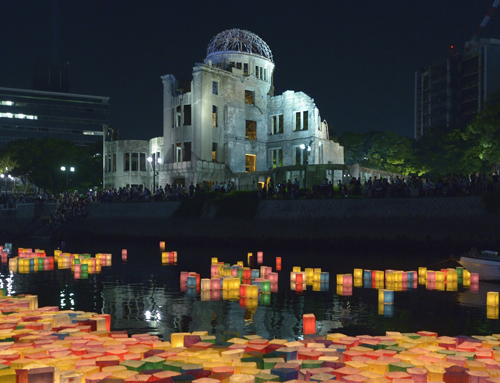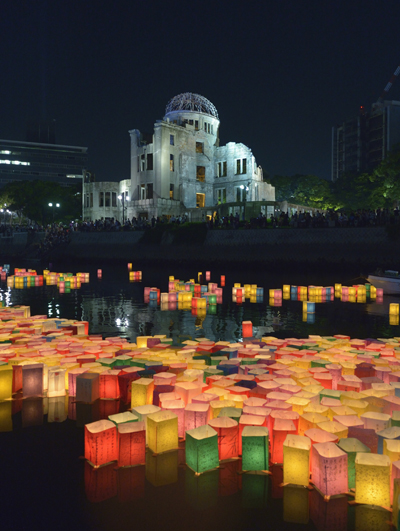
As negotiations continue at the UN in New York, JONATHAN FRERICHS, formerly programme executive for peace building and disarmament at the World Council of Churches, writes about the progress being made towards a treaty banning nuclear weapons…
Banning nuclear weapons is something like climbing a mountain. The summit of this mountain – agreement on a ban treaty – is now clearly in view at United Nations negotiations in New York.
The path has been steep in three weeks of talk, yet morale is good and progress has been steady. The high ground ahead could still be difficult. Nuclear powers actively oppose the ban. But on 7th July, when talks end, the prospects are good that negotiators from more than 130 countries will stand together on a peak no one else has climbed.

Candle lanterns drift downstream on 6th August, 2015, in Hiroshima, Japan, in front of the city’s atomic bomb dome. The floating lanterns, thousands of which were launched on the 70th anniversary of the atomic bombing of the city. PICTURE: Paul Jeffrey/WCC
“The path has been steep in three weeks of talk, yet morale is good and progress has been steady. The high ground ahead could still be difficult. Nuclear powers actively oppose the ban. But on 7th July, when talks end, the prospects are good that negotiators from more than 130 countries will stand together on a peak no one else has climbed.”
Many features of the new Treaty on the Prohibition of Nuclear Weapons are already quite clear. Its legally binding prohibitions, for example, are made-to-measure for a difficult task. “Each State Party undertakes never under any circumstances to: Develop, test, produce, manufacture, otherwise acquire…use or threaten to use nuclear weapons”, the treaty’s third draft says.
The preamble recognises the complete elimination of the weapons as the only sure guarantee that “nuclear weapons are never used again under any circumstances”. Some 159 governments have endorsed this precise formula in the years leading up to current talks.
The preamble declares that “the catastrophic consequences of nuclear weapons cannot be adequately addressed, transcend national borders, pose grave implications for human survival, the environment…and for the health of current and future generations…”
It further cites the “disproportionate impact” of ionising radiation “on women and girls”, reflecting significant scientific evidence about nuclear weapons that has been ignored since the bombing of Hiroshima but is now seeing the light of day.
Robust provisions for victim assistance, environmental remediation and international cooperation are an especially important part of the treaty for civil society and church advocates. These reflect a humanitarian approach to disarmament which members and governing bodies of the World Council of Churches (WCC) have been advocating for the past seven years with governments that have or rely on nuclear weapons and with governments that are nuclear-free. The WCC Commission of the Churches on International Affairs is representing the WCC with more such advocacy now.
States will be obliged to provide “age- and gender-sensitive assistance, without discrimination, including medical care, rehabilitation and psychological support” to people affected by the use or testing of nuclear weapons. The treaty cites international humanitarian and human rights law as a basis for such obligations.
Three weeks of negotiations have produced three successive drafts, each one an improvement. Civil society including churches is urging governments to add “test” and “threaten to use” to the core prohibitions, as cited above, for example. However, a similar lobby has not been successful so far in banning “military plans and preparations”, as the Chemical Weapons Convention does for chemical weapons of mass destruction.
Revisions are still possible in the remaining week of talks, but securing approval for the final draft from the nearly 140 capitals involved will take precedence in the final days.
“The treaty on the table does the job,” Beatrice Fihn told participants in the International Campaign to Abolish Nuclear Weapons (ICAN). “It’s the tool we all need for the hard work ahead”, she said. WCC is a partner in ICAN.
The negotiators will not be alone on the summit. The draft treaty acknowledges the principled efforts of others engaged in reaching the same goal: “the United Nations, the International Red Cross and Red Crescent Movement, other international and regional organizations, non-governmental organisations, religious leaders, parliamentarians, academics and the Hibakusha”. As one participant noted during a panel at the UN last week organised by Catholic organisations including Pax Christi International, almost everyone advocating for the ban is motivated in one way or another by faith.
Jonathan Frerichs, consultant, recently retired from the World Council of Churches where he had been the programme executive for peace building and disarmament. This article was first published on the World Council of Churches website.





